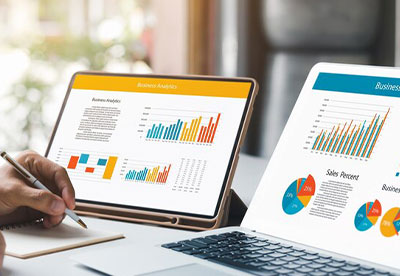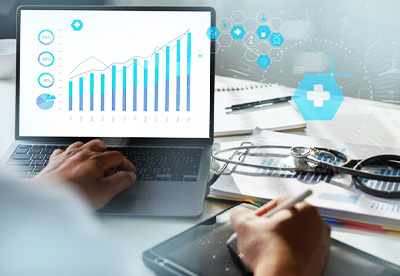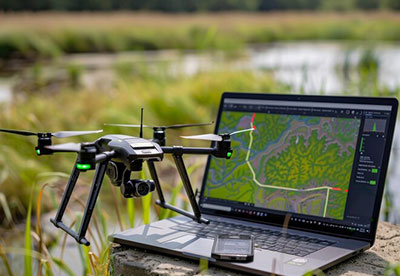Data visualization is crucial for understanding and utilizing data in today’s increasingly data-driven world. With the right visualization methods and tools, individuals and organizations can gain valuable insights from their data and make more informed decisions. Now let us understand the importance of data visualization in different industries.
Importance of Data Visualization in Different Industries
Importance of Data Visualization in Analytics
Data visualization plays a crucial role in analytics, allowing individuals to quickly and easily identify patterns, trends, and outliers in large data sets. This can be especially useful in fields such as business, finance, and scientific research, where decisions are often made based on data analysis.
By visualizing data, analysts can more easily identify areas of interest and focus their analysis on those areas. Additionally, data visualization can communicate complex information to a large audience, regardless of technical expertise. This can be especially useful for explaining the results of an analysis to non-technical stakeholders.
Importance of Data Visualization in Business Intelligence
Data visualization is a key component of Business Intelligence (BI) as it allows businesses to make sense of their data and make better decisions. By visualizing data, businesses can identify patterns, trends, and outliers in their data, which can help them understand their customers and improve their operations.
Data visualization can be used to create interactive dashboards that allow businesses to monitor key performance indicators in real-time. This can be especially useful for businesses as it will enable them to quickly identify areas of concern and make adjustments to their operations as needed. Additionally, data visualization can be used to create reports that can be shared with stakeholders, such as executives and investors, to provide them with a clear and concise view of the business’s performance, understand the position of products in the market, and predict sales volume.
Importance of Data Visualization in Healthcare
Data is a crucial aspect of the healthcare industry as it is used to understand and improve patient outcomes. With the rise in the use of electronic health records, healthcare organizations have access to large amounts of data, which can be analyzed and visualized to identify patterns and trends.
Data visualization can also be used to improve healthcare operations. For example, by visualizing data on patient wait times, healthcare organizations can identify bottlenecks and inefficiencies in their operations. By addressing these issues, they can improve patient satisfaction and reduce costs.
Data visualization also plays a crucial role in medical research. By visualizing data from clinical trials, researchers can identify patterns that may indicate the efficacy of a particular treatment. This can help to accelerate the development of new treatments and improve patient outcomes.
Importance of Data Visualization in Machine Learning
Data visualization also plays an important role in evaluating and improving the performance of machine learning models. By visualizing the results of our models, we can identify areas where the model is performing well and where it is struggling. This can help us pinpoint specific areas that need improvement and adjust our models accordingly. For example, visualizing the decision boundaries of a classification model can help us understand how well the model is separating different classes and what features are most important.
Importance of Data Visualization in Data Science
Data visualization is essential to data science because it allows us to make sense of large and complex data sets. By visualizing data, we can identify patterns and trends that would be difficult to spot otherwise. This can help us make more informed decisions and extract insights from the data.
For example, a retail company wants to understand its customer purchase behavior. A data scientist would collect data on customer demographics, purchase history, and browsing history. Then the data scientist would use data visualization techniques to represent this data in charts, graphs, and maps. By visualizing this data, the data scientist may discover that a particular demographic tends to purchase more during a specific time of the year or that certain products are frequently bought together. This information can then inform marketing strategies and optimize inventory management.
Future of Data Visualization
The future of data visualization looks promising as new technologies and methods continue to emerge. Some of the key trends in data visualization include:
- Increased use of virtual and augmented reality: With the rise of VR and AR technologies, data visualization is expected to become more immersive and interactive. Users can explore data in new and engaging ways, making it easier to understand complex information.
- Wider use of artificial intelligence and machine learning: AI and ML are used to automate the data visualization process, making it faster and more efficient. The technology can also be used to create more accurate and sophisticated visualizations and to identify patterns and insights that would be difficult to spot manually.
- More emphasis on real-time data visualization: The growth of IoT and other connected devices has accelerated the growth of the amount of real-time data being generated. This trend is driving the development of new tools and technologies that can quickly and effectively visualize real-time data, enabling users to make more informed decisions.
- Greater use of 3D and spatial data visualization: With the increasing amount of spatial data being generated, 3D and spatial data visualization will become more important. This will enable users to better understand and analyze spatial data and make it easier to identify patterns and trends in the data.
The future of data visualization is expected to bring more advanced, efficient, and interactive methods for data representation and analysis. As data becomes more complex and voluminous, new methods and technologies will continue to emerge to help users extract insights and make informed decisions.
Reasons Why You Need Business Analytics
4 mins read


















